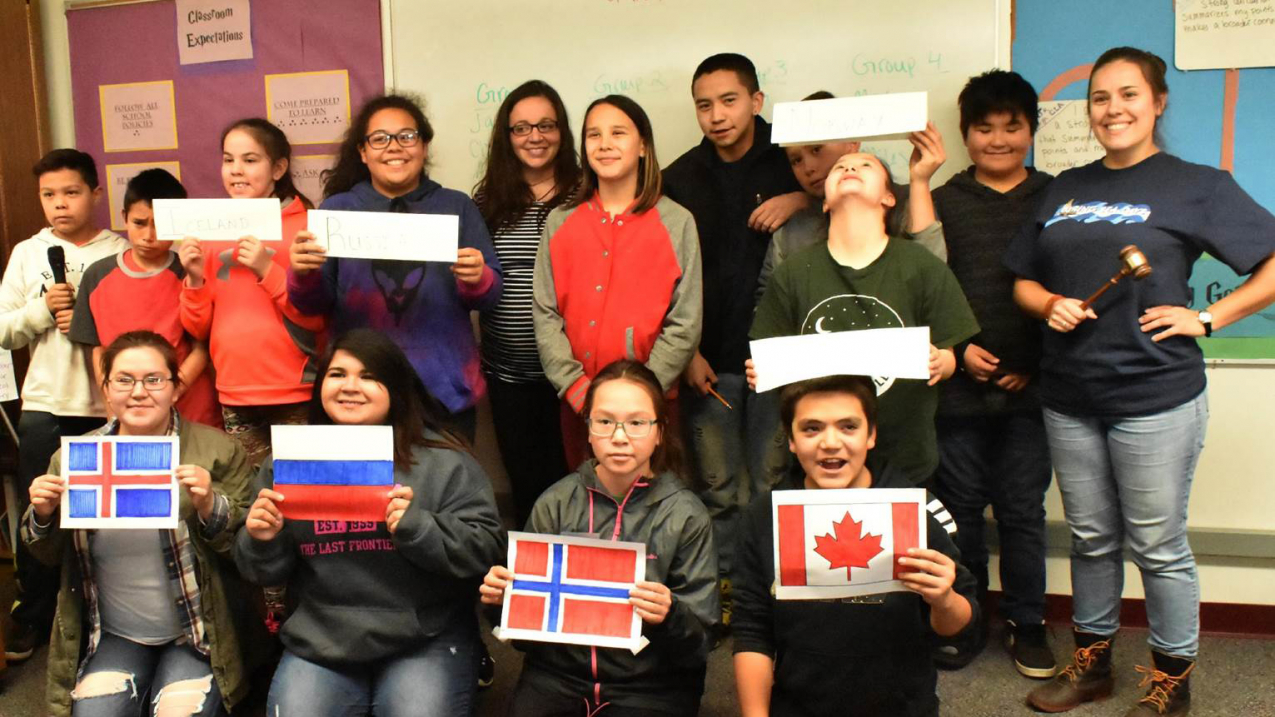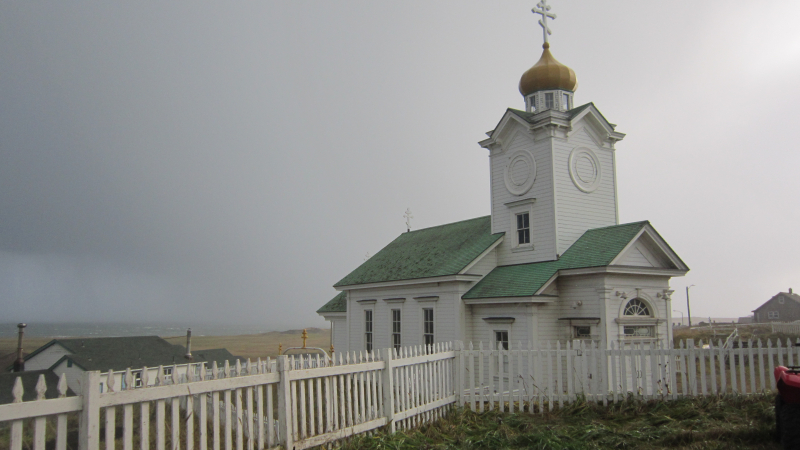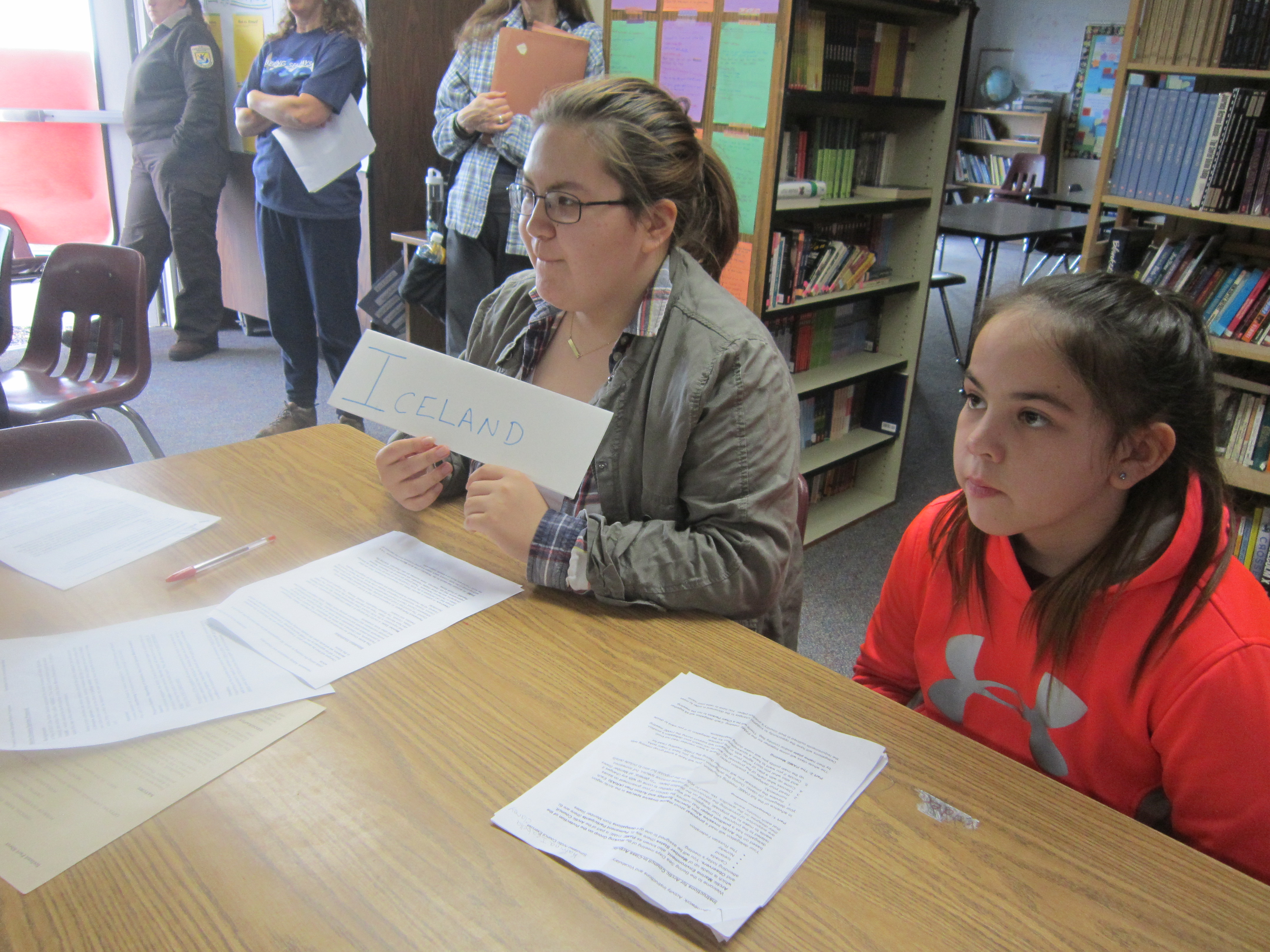by Dr. Ellie Bors, 2017 Knauss Marine Policy Fellow
Last October, about nine months into my Sea Grant Knauss Marine Policy Fellowship, I found myself on a remote island, several hundred miles off the coast of Alaska, talking passionately about running basketball plays and developing team strategies. For a lesson on the Arctic Council, I thought, we’ve strayed into unexpected territory.

Knauss Marine Policy Fellow, Dr. Ellie Bors (right) designed an Arctic Council simulation for students on St. Paul Island, Alaska, during Bering Sea Days. (Image credit: NOAA)
I was teaching the middle and high school students on St. Paul Island about how governments work together to develop strategy and action plans to tackle environmental problems. The students were getting the message — apparently consensus decision-making and group action leads to success in international negotiations, as well as in team sports.
St. Paul Island is one of the Pribilof Islands, a cluster of islands that sit in the middle of the Bering Sea, not far from the break of the continental shelf. St. Paul is by far the most isolated place I’ve visited in the United States, a place where two-thirds of the commercial flights to the island are cancelled and where shipments of food and supplies are frequently delayed due to weather and transport issues. Last year, 2017, was the 10-year anniversary of Bering Sea Days, a week-long outreach event with the school on the island. The stars aligned for me to travel to St. Paul to participate in Bering Sea Days during my fellowship.
I spent my Knauss Fellowship year working in the Office of International Affairs at NOAA in Washington, DC. My portfolio included issues related to the Arctic Council offsite link, an intergovernmental forum promoting cooperation, coordination and interaction in the Arctic region, in particular on issues of sustainable development and environmental protection. My work focused on invasive marine species in the Arctic, which drew on my scientific background studying the genetics of invading species during my dissertation. Two colleagues, Linda McCann from the Smithsonian Environmental Research Center offsite link and Linda Shaw from the NOAA Fisheries Alaska Regional Office, are actively involved in invasive species research in Alaska. They were in contact with the Aleut Community of St. Paul Tribal Government and were planning a trip to the island that coincided with Bering Sea Days. NOAA Fisheries Alaska Fisheries Science Center and Alaska Regional Office have been involved with Bering Sea Days from its inception because of their involvement with northern fur seal research, but this was the first time to Bering Sea Days for my colleagues. They invited me to join them, and I enthusiastically accepted.

On an island of approximately 500 permanent residents, the St. Paul school is home to about 60 students from pre-K through 12th grade. During Bering Sea Days, visiting scientists and educators work with the teachers from the school to build a rigorous schedule of classroom activities and field trips that highlight local marine research. The event challenges students to think about their local environment and gives them a broad perspective on what kinds of interests or careers they can build in the future. Every visiting participant had certain expertise to share with students, ranging from archaeology to sea bird biology to geochemistry. My colleagues and I developed lessons about invasive species alongside educators at the U.S. Fish and Wildlife Service. I also spearheaded an Arctic Council Simulation, an ambitious and challenging lesson for the middle and high school students.
To introduce students on St. Paul to the way an international meeting works, the Arctic Council lesson simulated a meeting of the Protection of the Arctic Marine Environment Working Group. During the exercise, students negotiated a fictional proposal related to invasive marine species. We assigned each student to one of four delegations from Arctic Council nations: Iceland, Norway, Russia, and Canada. Each delegation had a fictional position paper — a document that outlines a country’s position during international negotiations. The first part of class was spent in break-out delegation meetings where the students had to work together to understand how their country’s position related to the fictional proposal. Then we all came together in the format of a real international meeting.

Having written the simulated proposal and the position papers, I thought I had some sense of what would happen, of how the meeting would unfold. However, I was extremely impressed and excited when students started to apply concepts from specific parts of their position papers to other issues in the proposal. They were thinking on the fly like a well-oiled sports team; communicating with each other and creatively coming up with new plays and moves in response to each other’s actions. For example, one delegation advocated for flexibility in invasive species reporting, a position that was outlined in their preparatory materials. But then they also stepped back and applied that concept to the monitoring of ballast water, an issue not discussed in their specific position paper. The students of St. Paul really took the ball and ran with it!
My experience on St. Paul Island helped shape my understanding of the Arctic. I was able to apply knowledge from my fellowship year, meet extraordinary educators and scientists, and spend time on the stunning island of St. Paul. I will soon leave DC for a Postdoctoral Scholar position at Oregon State University studying how molecular biology can help determine the age of beluga whales in Alaska, and a Fulbright Scholar position through the Fulbright Arctic Initiative offsite link, during which I will undertake a research exchange to Norway to study shifts in the distribution of Arctic fish species. Memories from Bering Sea Days will follow me as I leave my Knauss Fellowship and move on to other exciting opportunities related to the Arctic.
Learn more about the Alaska Fisheries Science Center's role in Bering Sea Days and the Sea Grant Knauss Marine Policy Fellowship.



